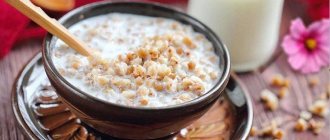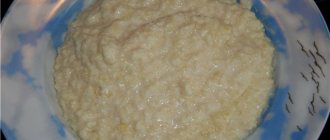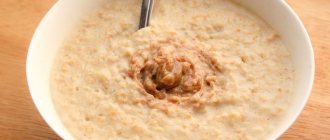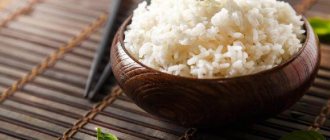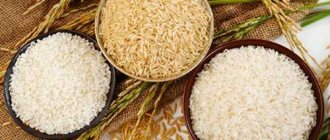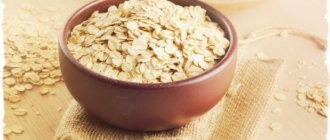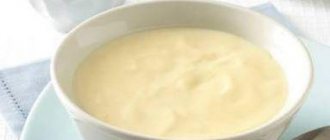You can give porridge to your baby from 4 months. Thanks to this complementary feeding, the baby will receive all the necessary vitamins and microelements.
Infants 4 months of age are often prescribed complementary feeding. More than 20 years ago, WHO recommended that children be fed only breast milk for up to 6 months. All pediatricians adhere to these recommendations, explaining to young mothers that the baby receives all the necessary vitamins and microelements for growth through breast milk.
- But situations are different: the mother does not have enough milk or she has lost it completely. What to do then? Introduce complementary foods!
- Useful vitamins and microelements help the growing body get porridge, which can be introduced as early as 4 months of age.
- The rules for introducing mixed nutrition must be discussed with your pediatrician. Indeed, often when a young mother begins to have problems with lactation, she panics, aggravating the situation. The doctor will tell you in what ways this process can be restored, and what to do if this does not work.
- But, if all measures are taken, but unsuccessfully, then complementary foods are introduced. What kind of porridge can a baby eat at a specific age? How to cook them? You will find answers to these and other questions in this article.
Is it possible and what kind of porridge can a child at 4 months eat?
Is it possible and what kind of porridge can a child at 4 months eat?
Complementary feeding at 4 months will be different for different children. If a baby is underweight, he is prescribed porridge, and babies with a good weight are given vegetable puree. Therefore, to the question: is it possible to give porridge to a child of 4 months, only a pediatrician can answer.
- Vegetable puree can be purchased in special baby food departments in stores and pharmacies, or you can prepare it yourself.
- To do this, take one vegetable, for example, zucchini, boil it until tender, grind it in a blender, and then pass it through a sieve.
- By the age of 6 months, children are allowed to be given vegetable puree from several boiled vegetables: zucchini and carrots, cauliflower and pumpkin, broccoli and other vegetables.
Important: If a child is allergic to a vegetable, it should be discontinued and the child should be taken to a pediatrician.
- Porridge is a source of microelements and vitamins. Even when our mothers and grandmothers were young, children were given 5% semolina porridge as complementary food.
- Modern pediatricians do not recommend feeding a child semolina, since it contains no nutrients, but only calories.
- The best option for complementary feeding at this age is liquid oatmeal, which is boiled in water or 1% milk.
- When ready, you need to rub it through a sieve and start giving it to your baby with 10 grams, increasing the portion daily to 100 grams. This complementary feeding is given for up to 6 months, and by 1 year the portion increases to 200 grams.
Important: At 4 months you can give mixtures and industrially produced cereals (such as “Baby” and others). They are sold in dry form and are ready for consumption only after dilution with water or breast milk.
What kind of cereals can a 4 month old baby eat?
- There are also a lot of vitamins in juices and fruit purees. But the juices should be freshly squeezed and light (apple or pear). Start introducing 1/4 teaspoon into your baby’s diet, up to 100 grams per day.
- Prepare fruit puree from an apple or a ripe and soft pear. Technique: Use a wooden spoon to scrape the pulp from an apple or pear. Give it right away so that the pulp does not oxidize. Start with a small portion (1/4 teaspoon) and work your way up to 50-100 grams per day.
- A baked apple is also very healthy for children, but it must be mashed and the pulp passed through a sieve.
Important: When introducing a new product into complementary foods, watch your baby. If an allergic reaction occurs, the product is removed from the diet. In addition, you should consult a pediatrician.
What kind of porridge can you prepare and how can you prepare porridge for complementary feeding for a 5, 6, 7, 8, 9, 10, 11 month old baby?
What kind of porridge can you prepare and how can you prepare porridge for complementary feeding for a 5, 6, 7, 8, 9, 10, 11 month old baby?
The first porridges should be easily digestible. They should not contain gluten, a vegetable protein. In addition, gluten causes allergies and is harmful not only to children, but also to adults. Read more about this in another article on our website. What kind of porridge can you prepare and how can you prepare porridge for complementary feeding for a 5, 6, 7, 8, 9, 10, 11 month old baby?
At 5 months, a child will benefit from porridge made from oats, rice, buckwheat and corn.
- To cook liquid porridge, you need to take 10-15 grams of dry mixture or separate cereal and 100 ml of 1% milk.
- To make milk with 1% fat content, just dilute regular store-bought milk (3.5%) with water 1:3.
- Boil the cereal in milk or water for 10 minutes, then cool, rub through a sieve and serve to your baby.
At 6 months, continue to prepare the same porridges as at 5 months.
- If your baby doesn’t eat this dish well, then try adding a little salt or pouring some sweet syrup on it.
- You cannot sprinkle porridge with sugar for a child, but you can cook light sugar syrup and pour it over the dish. Syrup recipe: Dissolve 10 grams of sugar in 50 ml of water and put on fire. Cook for 10-15 minutes. Pour this sweet water-syrup over the finished porridge, but not more than 10-15 grams per 100 grams of porridge.
- Monitor your child, if a rash appears, stop eating sugar. At this age, you can add up to 3 grams of butter and a little baked apple pulp to the finished porridge.
What porridges can be prepared as complementary foods for a 5, 6, 7, 8, 9, 10, 11 month old baby?
At 7 months, the diet is the same as at 5 and 6 months. If a child has unstable stool, then give preference to rice and corn porridge, and for constipation, cook a dish of oats and buckwheat.
At 8 months , you can try cooking porridge from barley if you are sure that the child tolerates gluten grains well. You can also combine several grains: barley and oats, wheat and rye, and so on.
At 9, 10, 11 months, introduce millet into complementary foods. Continue to give porridges from other cereals: oats, barley, rice, buckwheat and corn. In addition, at 9 months, one breastfeeding is completely replaced by 200 grams of porridge.
Important: By 11 months, your baby will already be eating almost all cereals, except semolina. It contains a lot of gluten and almost no vitamins and microelements. Therefore, if you still want to introduce semolina into your diet, then do it no earlier than a year.
Cooking features
- If you are preparing porridge for an infant, then do not rush to add butter, sugar, as well as salt and milk.
- A child at seven months can already prepare a dairy dish, but only by diluting it with water and only when there is no allergy to this product.
- A child of 1 year old no longer has to grind buckwheat before cooking. The exception is the absence of chewing teeth.
- If you are preparing porridge with a liquid consistency, you can offer your baby to eat it from a bottle. But, if the little one already knows how to eat from a spoon, then it is better not to use a bottle.
What kind of porridge can you prepare and how can you prepare porridge for complementary feeding of a one-year-old, 1.5 and 2-year-old child?
What kind of porridge can you prepare and how can you prepare porridge for complementary feeding of a one-year-old, 1.5 and 2-year-old child?
Please note that semolina reduces the absorption of calcium, and if given to a child under one year of age, rickets may develop. Therefore, as mentioned above, semolina porridge should be introduced into the baby’s diet no earlier than 12 months.
What other cereals can be given as complementary foods to a one-year-old, 1.5 and 2-year-old child, and how to prepare them? Here are some tips:
- Buckwheat porridge should be on a child’s menu every day, as it contains a lot of dietary fiber and vitamins. This is the most valuable porridge, it does not contain gluten and is rich in magnesium, potassium and phosphorus. It’s easy to prepare: wash 30 grams of buckwheat and pour in 100 ml of milk (1.5% fat). Cook for 10 minutes, cool and serve to your child. Can be boiled in water and served with meatballs.
- Rice porridge is rich in amino acids. But it is contraindicated for children who suffer from constipation. To prepare, rinse 30 grams of cereal and add low-fat milk or water (100-150 ml). Cook until the rice is done. If the porridge turns out thick, add a little boiled water.
- Corn porridge is rich in minerals and vitamins. Large amount of fiber. You need to cook it in water according to the rice porridge recipe. Serve this dish with meatballs or soufflé.
- Oatmeal contains a lot of vegetable proteins, dietary fiber, and vitamins. If a child has constipation, then this porridge will perfectly normalize stool. Cook thin porridge - the recipe is above.
What kind of porridge can you prepare and how can you prepare porridge for complementary feeding of a one-year-old or 1.5-year-old child?
Tip: At this age, you can add syrup and butter up to 5 grams to the porridge. Also, for taste, instead of sugar, you can add applesauce or banana puree.
After 1.5 years, the baby can be given porridge that does not need to be cooked. Such mixtures are sold in diet food departments. Just pour boiling water over the dry porridge and put it in the microwave for a minute - the porridge is ready.
Important: But be sure to look at the composition of the dry porridge. Often flavorings and flavorings are added to it. This kind of porridge should not be given to a baby!
The value of cereals
There are 110 kilocalories per 100 g of cooked porridge.
- Protein of plant origin is easily absorbed by the child’s body and actively stimulates the formation of muscle mass.
- Buckwheat contains a balanced composition of amino acids.
- The fiber contained in cereals affects the normalization of digestion and improves intestinal motility.
- The complex carbohydrates contained in buckwheat help you feel full. During the breakdown of these biologically active substances, energy is released.
My son has been very fond of eating buckwheat porridge since childhood. As I grew older, I began to prefer buckwheat with meat. Today he is completely indifferent to this cereal and prefers oatmeal.
At what age can you give it to a child and how to prepare delicious pea porridge for children: recipe
At what age can you give it to a child and how to prepare delicious pea porridge for children: recipe
Children are given pea porridge at the age of 1 year. Peas are healthy, but they are very difficult for the baby’s gastrointestinal tract, so introducing such porridge into complementary foods before a year is not recommended. How to cook delicious pea porridge for children? Here is the prescription:
- In the evening, rinse 100 grams of peas under water, cover with water and leave overnight.
- In the morning, rinse the cereal again, put it in a saucepan and add 200 grams of water.
- Place the container with the cereal on low gas and cook for about 30 minutes. If the water boils away quickly, then you need to add it little by little. Don't forget to stir the porridge constantly.
- When the cereal is almost ready, add a little salt and cook until the peas are completely cooked.
- Remove the pan from the heat, beat with a blender until smooth, add a little cream or butter. Pea porridge is ready.
At what age can you give it to a child and how to prepare delicious pea porridge for children: recipe
Porridge according to this recipe will turn out tender, soft and tasty. You can diversify this recipe by adding vegetable puree to the porridge. Boil onions, carrots, bell peppers. Grind in a blender and add a tablespoon of this puree to the porridge, stir a little.
Don't stir the buckwheat
Buckwheat porridge is considered the healthiest for a child. It is rich in vitamins and minerals (calcium, phosphorus, magnesium and especially iron) and improves the functioning of the gastrointestinal tract. If you cook buckwheat according to the rules, it will retain all its beneficial properties and turn out tasty and aromatic. First, pour the cereal into cold water (in a ratio of 1 to 2) and bring it to a boil. Then reduce the heat, close the lid and cook until all the liquid has evaporated. If you do not stir the porridge during cooking and do not add water to it, you will get a crumbly dish, 100 g of which contains 163 kcal (equal to 1/2 of a bun, but how much benefit!). Having made buckwheat in advance, you can always pour hot milk over it in the morning (these products go perfectly together), and in the evening add salt, add fried onions, butter, meat or chicken - and you will have a healthy dinner.
What kind of cereals can be used for constipation, diarrhea, and allergies in children?
What kind of cereals can be used for constipation, diarrhea, and allergies in children?
Every mother wants her baby to be healthy and feel great. After all, his mood, as well as the mood of the mother and all household members, depends on the child’s well-being. What kind of cereals can be used for constipation, diarrhea, and allergies in children? Using this dish, cooked from a specific grain, you can stop diarrhea or help with constipation.
- If a child is allergic to gluten , then do not cook him the following porridges: oatmeal, wheat, pearl barley, barley, semolina.
- If you are constipated, do not feed rice porridge. Cook oatmeal, flaxseed, pearl barley, corn, millet.
- If you have diarrhea, you should not give your baby flaxseed porridge, millet porridge (hard for the gastrointestinal tract), pearl barley, or corn. Give preference to cereals that make viscous porridges that help cope with loose stools: oatmeal, semolina, rice. Cook these porridges in water without sugar or salt.
Porridge is an important dish for a child’s body. With its help, you will diversify the menu and the baby will receive all the necessary microelements and vitamins, which means he will develop properly and grow quickly.

